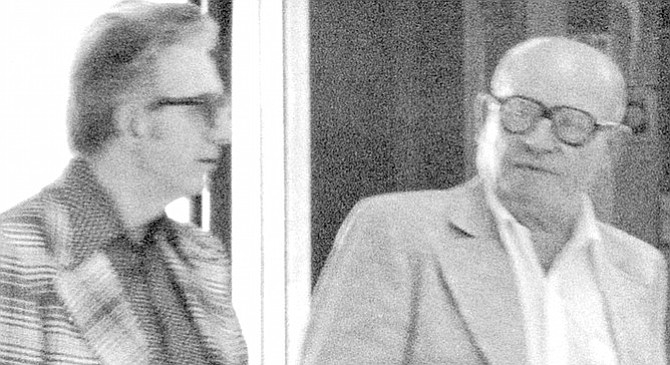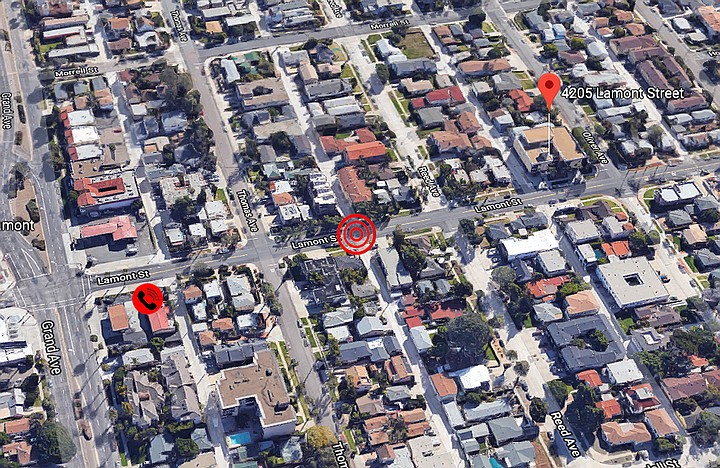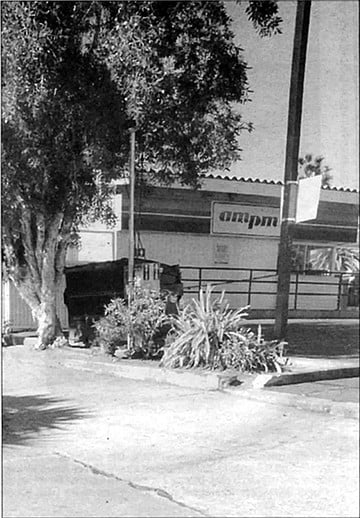 Facebook
Facebook
 X
X
 Instagram
Instagram
 TikTok
TikTok
 Youtube
Youtube

At the age of 16, Frank "The Bump" Bompensiero moved to San Diego in 1921 and bootlegged liquor during Prohibition. He eventually became a prolific mafia hitman famous for his "Italian rope trick," where he reputedly strangled his victims. He lived out the rest of his life in San Diego with the exception of his service during WWII, prison, and having to lay low at times.

He was shot to death 41 years ago today, on February 10, 1977, at about 8:30 p.m. near his apartment at 4205 Lamont Street in Pacific Beach. It was reported that he was heading back home after making a call at a pay phone by an Arco gas station two blocks down, at Lamont and Grand. He was shot at close range four times — once in the neck and three times in the head.
When police arrived on the scene, Bompensiero was found face-down in a pool of blood with three dimes and a half-smoked cigar at his side. Four .22-caliber automatic pistol shell casings were recovered. This wasn't known as a weapon of choice for mobsters, but it was known for keeping down the blood splatter when used at close range. Police speculated a silencer was used since no one reported hearing any shots fired. Bompensiero was declared dead on arrival at Mission Bay General Hospital. He was 71 years old.

In a recent interview with Kathleen, a lifelong San Diego resident, she said, "My late husband played a role in Bompensiero getting whacked. It wasn't intentional. He didn't even know who Bompensiero was until I told him, probably because he didn't grow up in San Diego."
The first time Kathleen heard Bompensiero's name was one day in the 1950s when her father drove her by a big house up on a hill in Point Loma. "I remember thinking it was strange because the side facing the harbor view had no windows. He pointed out the gun turrets and told me that Bompensiero lived there.
"My father wasn't the type to know mobsters, but everyone liked him and he loved talking to people. It wouldn't surprise me if he had crossed paths with Bompensiero."
Kathleen remembers Tarantino’s on Harbor Drive in Point Loma in the 1970s as a place where Bompensiero frequented. "My mother was neighbors with one of the bartenders. Bompensiero used to hang out in this corner booth in the bar when it was slow so he could conduct business and not be overheard.
"One time, we were having drinks with the owner's brother. He had a cement business. Out of the blue, my mother asks him, 'Aren't you afraid of finding a horse's head in your bed someday?' Luckily, he laughed." Kathleen said this was right after The Godfather came out in 1972. The movie has a scene where a gangster wakes up to find a horse's head in his bed.
Bompensiero was seen at Tarantino’s the afternoon of his death, sitting in his corner booth in the bar.
Kathleen's husband managed the now-defunct Elario's, a fancy penthouse restaurant and bar in La Jolla atop the Summer House Inn Hotel. The hotel is now called Hotel La Jolla. It's not known if Bompensiero ever visited Elario's, but Kathleen remembers seeing some questionable characters more than once when dining there.
According to Kathleen, Elario's in the 1970s was frequented by lots of big names from Hollywood, the music industry, politicians, and high-profile locals like "Mr. San Diego," C. Arnoldt Smith, a friend of Richard Nixon who was eventually caught up in a banking scandal.
In the 1980s, "former mayor Roger Hedgecock was a permanent fixture at Elario's. He used to stand at the bar and pontificate endlessly, refusing to sit down, not long before [he was pushed out of office for accepting illegal campaign contributions].
"My husband saw a lot working there. One time he set that actor, that played Grizzly Adams [Dan Haggerty], his beard on fire with a fancy flambé drink he was trying to impress him with. [Haggerty] was nice about it."
One night in February 1977, Kathleen's husband came home from work and told her about a conversation he’d had with one of the busboys, a young mentally challenged kid. "The general manager knew his mother; I think that's how he got the job.
"After closing, he sees the busboy with a lot of dimes. He asked if those were his tips. The busboy said he kept tips in one pocket and dimes in the other for phone calls. He asked him if he had a phone at home and the busboy said he did."
Kathleen said the busboy lived with his mother in Pacific Beach.
"He told my husband that he makes calls for his neighbor ‘Mr. Frank’ at the pay phone, that Mr. Frank gives him dimes and a phone number and gives him a word or two to say."
The busboy said Mr. Frank paid him for making the calls.
"My husband asked why he didn't make the calls from home or why Mr. Frank couldn't make his own calls. The kid said Mr. Frank couldn't get to the phone. My husband asked if Mr. Frank was handicapped. No. He finally asked the kid if Mr. Frank was his first name or his last name. That's when he told him his last name was Bompensiero.

"My husband didn't recognize the name. I filled him in on who Frank Bompensiero was. The next time he saw the busboy, he told him he had to stop making calls for Mr. Frank. He told him it was dangerous and he needed to avoid him, hide from him, not answer the door. I don't think he told him much more than that, but the kid promised."
Kathleen remembers a short time later that "the news reported Bompensiero had been shot at a phone booth in Pacific Beach."
I asked Kathleen if she remembered what she thought or felt when she heard the news.
"I was thinking I didn't know the networking of the mob or how many people Bompensiero spoke to. I didn't know if they would be angry if they ever found that we had anything to do with the kid not making those phone calls anymore. We didn't want anyone to know. We didn't know at the time [Bompensiero] was an island amongst himself — he was on the outs."

It was reported in March 1978 that five organized-crime figures were indicted for racketeering and Bompensiero's murder. The indictment and Bompensiero's murder were connected to a pornographic FBI sting operation that Bompensiero introduced associates into. This is what may have led the mob to suspect Bompensiero was an informant. Mafia FBI informants were being found out back then, likely due to sloppy record-keeping that allowed low-level clerks access.
One of the mobsters indicted in 1978 was Thomas "Tommy Fingers" Ricciardi. Bompensiero's close associate Jimmy "The Weasel" Fratianno, fingered Ricciardi as Bompensiero's hitman. Speculation is Fratianno ordered the hit himself or was coerced into it. Ricciardi died of a heart attack in 1979 before trial. Fratianno died in 1993 from complications of Alzheimer's after having been one of the most powerful mobsters to turn federal witness until Sammy "The Bull" Gravano brought down mob boss John Gotti of the Gambino crime family in 1991. Fratianno was dropped from witness protection in the 1980s after publishing a couple memoirs.


At the age of 16, Frank "The Bump" Bompensiero moved to San Diego in 1921 and bootlegged liquor during Prohibition. He eventually became a prolific mafia hitman famous for his "Italian rope trick," where he reputedly strangled his victims. He lived out the rest of his life in San Diego with the exception of his service during WWII, prison, and having to lay low at times.

He was shot to death 41 years ago today, on February 10, 1977, at about 8:30 p.m. near his apartment at 4205 Lamont Street in Pacific Beach. It was reported that he was heading back home after making a call at a pay phone by an Arco gas station two blocks down, at Lamont and Grand. He was shot at close range four times — once in the neck and three times in the head.
When police arrived on the scene, Bompensiero was found face-down in a pool of blood with three dimes and a half-smoked cigar at his side. Four .22-caliber automatic pistol shell casings were recovered. This wasn't known as a weapon of choice for mobsters, but it was known for keeping down the blood splatter when used at close range. Police speculated a silencer was used since no one reported hearing any shots fired. Bompensiero was declared dead on arrival at Mission Bay General Hospital. He was 71 years old.

In a recent interview with Kathleen, a lifelong San Diego resident, she said, "My late husband played a role in Bompensiero getting whacked. It wasn't intentional. He didn't even know who Bompensiero was until I told him, probably because he didn't grow up in San Diego."
The first time Kathleen heard Bompensiero's name was one day in the 1950s when her father drove her by a big house up on a hill in Point Loma. "I remember thinking it was strange because the side facing the harbor view had no windows. He pointed out the gun turrets and told me that Bompensiero lived there.
"My father wasn't the type to know mobsters, but everyone liked him and he loved talking to people. It wouldn't surprise me if he had crossed paths with Bompensiero."
Kathleen remembers Tarantino’s on Harbor Drive in Point Loma in the 1970s as a place where Bompensiero frequented. "My mother was neighbors with one of the bartenders. Bompensiero used to hang out in this corner booth in the bar when it was slow so he could conduct business and not be overheard.
"One time, we were having drinks with the owner's brother. He had a cement business. Out of the blue, my mother asks him, 'Aren't you afraid of finding a horse's head in your bed someday?' Luckily, he laughed." Kathleen said this was right after The Godfather came out in 1972. The movie has a scene where a gangster wakes up to find a horse's head in his bed.
Bompensiero was seen at Tarantino’s the afternoon of his death, sitting in his corner booth in the bar.
Kathleen's husband managed the now-defunct Elario's, a fancy penthouse restaurant and bar in La Jolla atop the Summer House Inn Hotel. The hotel is now called Hotel La Jolla. It's not known if Bompensiero ever visited Elario's, but Kathleen remembers seeing some questionable characters more than once when dining there.
According to Kathleen, Elario's in the 1970s was frequented by lots of big names from Hollywood, the music industry, politicians, and high-profile locals like "Mr. San Diego," C. Arnoldt Smith, a friend of Richard Nixon who was eventually caught up in a banking scandal.
In the 1980s, "former mayor Roger Hedgecock was a permanent fixture at Elario's. He used to stand at the bar and pontificate endlessly, refusing to sit down, not long before [he was pushed out of office for accepting illegal campaign contributions].
"My husband saw a lot working there. One time he set that actor, that played Grizzly Adams [Dan Haggerty], his beard on fire with a fancy flambé drink he was trying to impress him with. [Haggerty] was nice about it."
One night in February 1977, Kathleen's husband came home from work and told her about a conversation he’d had with one of the busboys, a young mentally challenged kid. "The general manager knew his mother; I think that's how he got the job.
"After closing, he sees the busboy with a lot of dimes. He asked if those were his tips. The busboy said he kept tips in one pocket and dimes in the other for phone calls. He asked him if he had a phone at home and the busboy said he did."
Kathleen said the busboy lived with his mother in Pacific Beach.
"He told my husband that he makes calls for his neighbor ‘Mr. Frank’ at the pay phone, that Mr. Frank gives him dimes and a phone number and gives him a word or two to say."
The busboy said Mr. Frank paid him for making the calls.
"My husband asked why he didn't make the calls from home or why Mr. Frank couldn't make his own calls. The kid said Mr. Frank couldn't get to the phone. My husband asked if Mr. Frank was handicapped. No. He finally asked the kid if Mr. Frank was his first name or his last name. That's when he told him his last name was Bompensiero.

"My husband didn't recognize the name. I filled him in on who Frank Bompensiero was. The next time he saw the busboy, he told him he had to stop making calls for Mr. Frank. He told him it was dangerous and he needed to avoid him, hide from him, not answer the door. I don't think he told him much more than that, but the kid promised."
Kathleen remembers a short time later that "the news reported Bompensiero had been shot at a phone booth in Pacific Beach."
I asked Kathleen if she remembered what she thought or felt when she heard the news.
"I was thinking I didn't know the networking of the mob or how many people Bompensiero spoke to. I didn't know if they would be angry if they ever found that we had anything to do with the kid not making those phone calls anymore. We didn't want anyone to know. We didn't know at the time [Bompensiero] was an island amongst himself — he was on the outs."

It was reported in March 1978 that five organized-crime figures were indicted for racketeering and Bompensiero's murder. The indictment and Bompensiero's murder were connected to a pornographic FBI sting operation that Bompensiero introduced associates into. This is what may have led the mob to suspect Bompensiero was an informant. Mafia FBI informants were being found out back then, likely due to sloppy record-keeping that allowed low-level clerks access.
One of the mobsters indicted in 1978 was Thomas "Tommy Fingers" Ricciardi. Bompensiero's close associate Jimmy "The Weasel" Fratianno, fingered Ricciardi as Bompensiero's hitman. Speculation is Fratianno ordered the hit himself or was coerced into it. Ricciardi died of a heart attack in 1979 before trial. Fratianno died in 1993 from complications of Alzheimer's after having been one of the most powerful mobsters to turn federal witness until Sammy "The Bull" Gravano brought down mob boss John Gotti of the Gambino crime family in 1991. Fratianno was dropped from witness protection in the 1980s after publishing a couple memoirs.
Comments